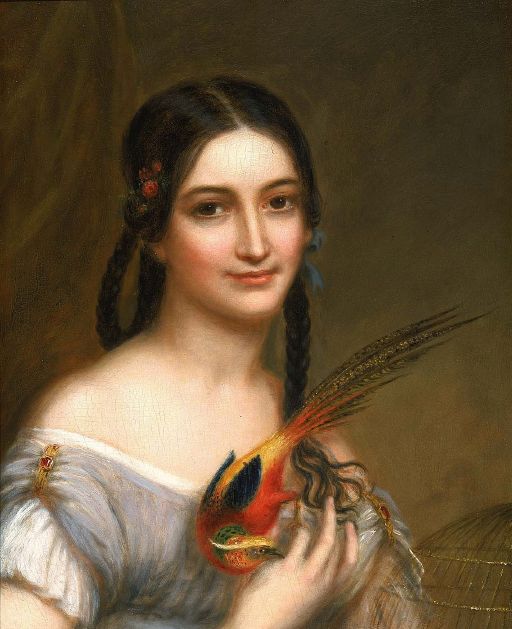Young Omaha, War Eagle, Little Missouri and Pawnees 1821
Sharitarish (Wicked Chief) 1822
 |
| Petalesharro (Generous Chief) 1822 |
Hayne Hudjihini (Eagle of Delight) 1822
Black Hawk, Chief of the Sauk and Fox
Profile of Thomas Jefferson
Miss Satterlee
Charles Bird King (1785 - 1862) was an American artist born in Rhode Island. Though he painted a wide variety of subjects, he is primarily remembered today for his portraits of Native Americans. There is, I suppose, a twist of irony in King's choice of subject matter since King's father, a veteran of the American Revolution, was killed by Native Americans while the family was traveling in Ohio, when King was four years old.
Charles Bird King - self portrait
I became familiar with King's vibrant work when, many years ago, I added The American Heritage Book of Indians to my personal library. The book's designer used King's most famous painting on its cover.
(This is not a photo of my own copy which is in slightly better shape.)
Among several other artists working at around the same time, was George Catlin (1796 - 1892), who specialized in paintings of Native Americans and their culture. Catlin actually traveled west and lived among the tribes he painted in situ.
A buffalo hunt by George Catlin.
King, however, who had established himself as a successful painter, preferred to stay in Washington D.C. and have his subjects come to him when they happened to visit the city.
Both artists' surviving work (many of King's paintings were lost in a fire) is stored and on display at the Smithsonian Institute in Washington, D.C.
To read more about Charles Bird King, his life and work, please use this link.
This link will take you to George Catlin's bio.
Catlin's portrait of a Blackfood Chief.













Beautiful paintings of Native people. What more can I say? That's what they are, quite well come.
ReplyDeleteDo you know the Edward Curtis photographs of Native people?
Kathy: Something a little different for this Saturday. Yes, I know of Curtis's photos. He did amazing work.
ReplyDeleteI meant to say they were quite "well done."
ReplyDeleteCurtis' work was amazing. My aunt who went to college in Oklahoma always loved Curtis work, had books and photos of his around her NYC apartment.
Thomas Jefferson suddenly looks a bit bleak :)
ReplyDeleteKathy: Another great photographer of the time was, of course, Matthew Brady.
ReplyDeleteI may be in the minority, but I like the profile of Jefferson. I think it makes him look more human than just about any other painting of Jefferson I've seen.
ReplyDeleteLovely paintings, romanticized of course, but I would hope an artist would be kind enough to do that for me if my portrait is ever painted. The very top one is just beautiful, and one aspect of it interested me very much. It names some of the men, and then just says "Pawnees" -- the one in profile interested me. His profile is just like one of the Roman Caesar's -- high bridge, long, beautiful man really. I always wonder about the origins of ethnicity, why different people show similar characteristics.
ReplyDeleteThe Catlin Blackfoot Chief is a great picture. I liked this post, Yvette.
Becky: I'm not sure how 'romanticized' the portraits were if the subjects themselves were actually wearing all that wonderful finery.
ReplyDeleteBut maybe the point of view was - juat a little.
These artists (and many others) left us such a fine record of a vanishing America.
They remind me of a lot of the painting that sit in the Indian Center, which is a few block from my house.
ReplyDeleteRyan: Are the paintings in your area from the 18th and 19th century? Or modern interpretations?
ReplyDelete